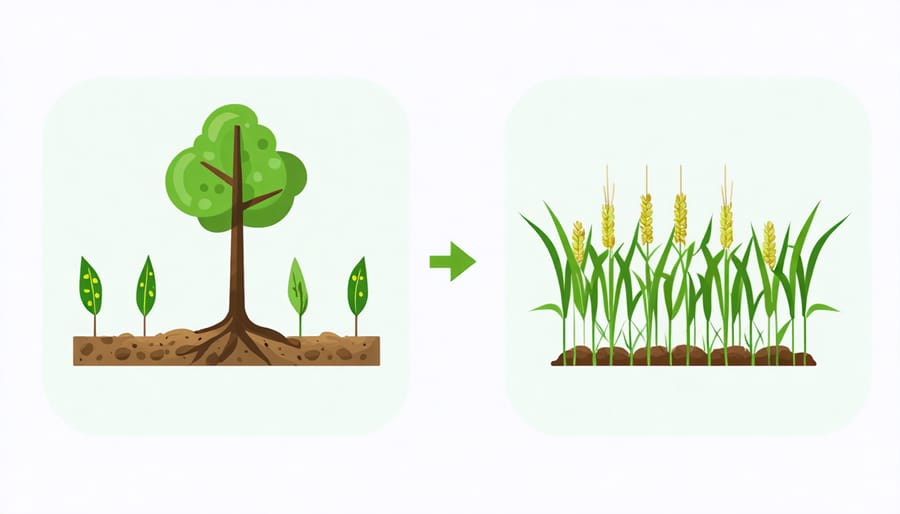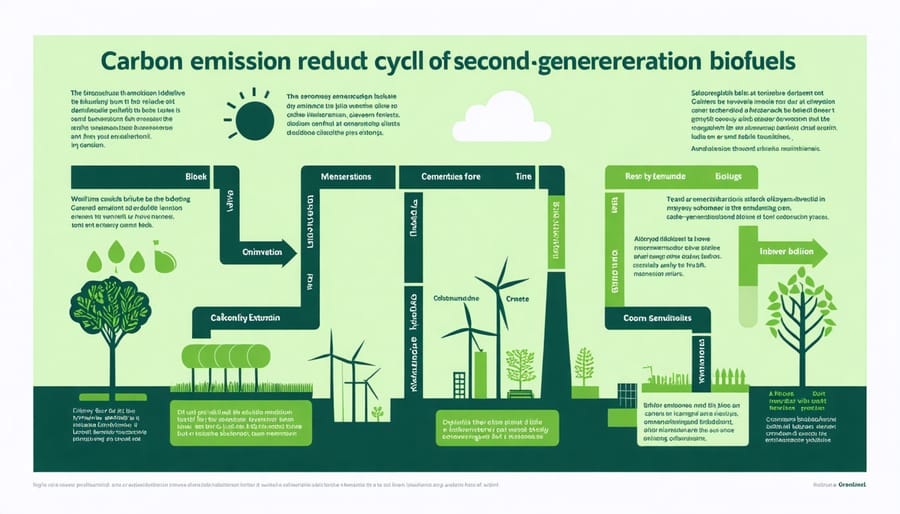Second-generation biofuels stand at the forefront of sustainable energy innovation, transforming agricultural waste and non-food crops into powerful, clean-burning fuels. Unlike their first-generation predecessors, these advanced biofuels tackle two critical challenges: reducing competition with food production and maximizing land use efficiency. As Australia’s renewable energy landscape evolves, these next-generation fuels are revolutionizing how we think about biomass conversion and energy sustainability.
By harnessing cutting-edge enzymatic processes and thermochemical conversion technologies, second-generation biofuels extract energy from previously unusable materials like corn stalks, wheat straw, and purpose-grown energy crops on marginal lands. This breakthrough represents more than just technological advancement – it’s a fundamental shift in our approach to renewable energy, offering a practical solution to reduce greenhouse gas emissions while supporting agricultural communities.
The innovation behind these advanced biofuels doesn’t just promise environmental benefits; it opens new economic opportunities in rural areas and strengthens energy security through domestic production. As global demand for sustainable energy solutions grows, second-generation biofuels are proving that the future of renewable energy lies in smart resource utilization and innovative biotechnology.
Beyond Food vs. Fuel: The Rise of Advanced Biofuel Crops
What Makes a Biofuel ‘Second Generation’?
Second-generation biofuels represent a significant leap forward in sustainable energy production, distinguished by their use of non-food biomass sources. Unlike their first-generation counterparts, these advanced biofuels are produced from agricultural residues, forestry waste, and purpose-grown energy crops that don’t compete with food production.
What sets these biofuels apart is their ability to utilize the entire plant material, including cellulose and lignin, rather than just the easily accessible sugars and oils. This means farmers can harvest their primary crops for food while converting the leftover stalks, leaves, and husks into valuable fuel.
In Australia, where sustainable land use is crucial, second-generation biofuels offer a clever solution. They can be produced from native plants like mallee eucalyptus, which thrives in marginal farmland and helps combat soil salinity. These biofuels also make use of agricultural waste from wheat and sugarcane production, turning what was once considered rubbish into a valuable resource.
The environmental footprint of these advanced biofuels is significantly smaller than their predecessors, with higher energy yields per hectare and reduced greenhouse gas emissions throughout their lifecycle.

Breaking Down the Biomass Barrier
Breaking down tough plant material into usable biofuel is like unlocking a stubborn safe – it requires the right combination of techniques. The main challenge lies in separating two key components: lignin, the woody material that gives plants their structure, and cellulose, the energy-rich substance we’re after.
The process starts with pre-treatment, where plant material is exposed to heat, pressure, and sometimes chemicals to soften the lignin’s grip. Think of it as loosening a tight knot before untying it. Next comes the clever bit – specially designed enzymes go to work breaking down the cellulose into simple sugars, much like how termites digest wood in nature.
Australian researchers have made significant breakthroughs in this field, developing more efficient enzymes that work faster and cost less. They’ve even found success using native eucalyptus species, which are naturally adapted to our climate. The resulting sugars are then fermented into ethanol, similar to how beer is made, but with a much more sustainable purpose.
Recent innovations in this process have cut processing time nearly in half while improving yield, making second-generation biofuels increasingly viable for commercial production.
Australian Innovation in Bioenergy Crops
Native Species Leading the Charge
Australia’s unique flora is proving to be a game-changer in the biofuel industry, with several native species showing remarkable potential for sustainable energy production. Leading the charge is Mallee eucalyptus, a hardy tree naturally adapted to Australia’s challenging climate. These trees not only produce high-quality biomass but also help combat soil salinity, making them a dual-purpose crop for farmers.
Another promising candidate is the native grass species Triodia, commonly known as spinifex. Traditional Indigenous knowledge has long recognised its value, and modern research has revealed its excellent potential for biofuel production due to its high cellulose content and minimal water requirements.
Australian scientists are also exploring the potential of native legumes like Acacia saligna, which can thrive in marginal lands while enriching soil nitrogen levels. This makes them particularly valuable for rehabilitating degraded agricultural areas while producing biofuel feedstock.
What makes these native species particularly attractive is their natural resilience to Australia’s harsh conditions. They require minimal irrigation, resist common pests, and have evolved to flourish in nutrient-poor soils. These characteristics significantly reduce the environmental footprint of biofuel production while ensuring consistent yields even in challenging conditions.
Local farmers are increasingly incorporating these native species into their operations, creating innovative agroforestry systems that balance food production with biofuel crops. This approach is helping to establish a sustainable, uniquely Australian solution to our renewable energy needs.
Agricultural Waste to Energy Gold
Australia’s agricultural sector is turning what was once considered waste into valuable biofuel gold. Farmers across the country are discovering innovative ways to convert their agricultural residues into sustainable energy sources. From sugar cane bagasse in Queensland to wheat straw in Western Australia, these agricultural by-products are proving to be valuable resources for second-generation biofuel production.
One standout example is the conversion of rice husks in New South Wales’ Riverina region. Local processors are using advanced fermentation techniques to transform these typically discarded husks into bioethanol, creating a new revenue stream while reducing waste. Similarly, corn stover – the leaves, stalks, and cobs left after harvest – is being collected and processed into biofuel at facilities in Victoria’s agricultural belt.
The wine industry has also jumped on board, with innovative vineyards in South Australia converting grape marc (the solid remains from wine pressing) into bioethanol. This circular economy approach not only addresses waste management but also produces clean energy.
Cotton farmers are finding value in gin trash – the leaves, stems, and other residues from cotton processing. These materials, previously burnt or left to decompose, are now feeding biofuel refineries, demonstrating how agricultural waste can become a valuable energy resource while supporting regional development and creating new jobs in rural communities.
These success stories showcase how Australian agriculture is leading the way in sustainable biofuel production, turning yesterday’s waste into tomorrow’s energy solution.

Breakthrough Crop Technologies
Recent breakthrough biotechnology innovations have revolutionized how we approach biofuel crop production. Australian researchers have developed resilient crop varieties that can thrive in marginal lands, reducing competition with food agriculture while maximizing biofuel yield.
One significant advancement is the development of enhanced switchgrass varieties that produce up to 30% more biomass than traditional strains. These super-crops are engineered to have stronger cell walls, making them more resistant to pests and diseases while containing higher concentrations of fermentable sugars.
Gene editing techniques have also enabled the creation of eucalyptus variants specifically designed for biofuel production. These trees grow faster, require less water, and produce wood that’s easier to break down into biofuel. This innovation is particularly valuable for Australia’s climate and has already shown promising results in pilot programs across Victoria and South Australia.
Agricultural scientists have made remarkable progress with enzyme engineering, developing new catalysts that significantly improve the efficiency of converting plant matter into biofuel. These enzymes can break down tough plant materials more effectively, reducing processing time and energy requirements.
The integration of smart farming techniques with these crop innovations has created a synergistic effect, optimizing growth conditions through precision agriculture and real-time monitoring. This combination has led to unprecedented improvements in yield and sustainability, making second-generation biofuels increasingly viable for commercial production.
Environmental and Economic Benefits
Carbon Footprint Reduction
Second-generation biofuels represent a significant leap forward in reducing carbon emissions compared to both fossil fuels and their first-generation counterparts. These advanced biofuels can slash greenhouse gas emissions by up to 90% compared to conventional petroleum fuels, making them a game-changer in our fight against climate change.
Unlike first-generation biofuels, which often compete with food crops and require extensive agricultural resources, second-generation biofuels utilize waste materials and non-food crops, effectively reducing the overall carbon footprint of the production process. In Australia, where agricultural waste is abundant, this approach transforms what would otherwise be discarded materials into valuable, low-carbon fuel sources.
The environmental benefits extend beyond just emissions reduction. The cultivation of dedicated energy crops for second-generation biofuels can help rehabilitate degraded farmland and increase biodiversity. For instance, native Australian grasses used in biofuel production can improve soil health and provide habitat for local wildlife while serving as a sustainable fuel source.
The lifecycle assessment of second-generation biofuels shows remarkable improvements in water usage and land efficiency. By utilizing existing agricultural waste streams and purpose-grown crops on marginal lands, these biofuels minimize the environmental impact associated with traditional fuel production. This circular economy approach not only reduces waste but also creates a sustainable energy cycle that benefits both the environment and agricultural communities.

Regional Economic Growth
Second-generation biofuels are creating exciting economic opportunities across rural Australia, particularly in agricultural communities. Farmers are discovering new revenue streams by incorporating energy crops into their existing operations, effectively diversifying their income sources while contributing to sustainable energy production.
In regions like the Wheatbelt of Western Australia and Queensland’s agricultural corridor, farmers are increasingly cultivating crops specifically for biofuel production alongside their traditional farming activities. This dual-purpose approach has led to increased farm productivity and year-round employment opportunities for local communities.
The establishment of regional biofuel processing facilities has created numerous jobs in rural areas, from agricultural workers to skilled technicians and facility managers. For example, the development of a biomass processing plant in northern Victoria has generated over 100 direct jobs and supported dozens of local businesses in its supply chain.
Small towns are experiencing renewed economic vitality as biofuel industries attract investment and create employment opportunities. Local transport companies, equipment suppliers, and maintenance services are all benefiting from this growing sector. Additionally, the industry is creating opportunities for young people to remain in rural communities through apprenticeships and technical training programs.
The ripple effect extends to research and development, with regional universities and agricultural institutions establishing specialized programs to support the industry’s growth, further strengthening local economies and fostering innovation in rural Australia.
Future Directions and Opportunities
Scaling Up Production
Scaling up second-generation biofuel production from pilot projects to commercial operations presents both challenges and opportunities for Australia’s renewable energy sector. The primary hurdle lies in establishing efficient supply chains for agricultural waste and woody biomass, particularly in remote areas. However, innovative solutions are emerging, with several regional hubs now implementing coordinated collection networks that connect farmers with processing facilities.
Investment in infrastructure remains crucial, with major projects like the Northern Oil Advanced Biofuels Pilot Plant in Gladstone leading the way. This facility has successfully demonstrated how to overcome initial scaling challenges through strategic partnerships between agriculture and industry. The key to their success has been the development of modular processing units that can be deployed closer to biomass sources, reducing transportation costs significantly.
To support commercial scaling, government initiatives are providing vital funding and regulatory frameworks. The Australian Renewable Energy Agency (ARENA) has been instrumental in backing projects that show promise for large-scale implementation. Industry leaders are also adopting sophisticated preprocessing technologies and automated systems to enhance efficiency and reduce operational costs, making the transition to commercial-scale production more viable than ever before.
Integration with Existing Infrastructure
Second-generation biofuels are designed to seamlessly integrate with existing energy systems, making them a practical solution for Australia’s transition to renewable energy. Many of our current fuel terminals, storage facilities, and distribution networks can be adapted to handle these advanced biofuels with minimal modifications.
The beauty of second-generation biofuels lies in their compatibility with conventional engines and infrastructure. Unlike some alternative energy sources, these biofuels can be blended with traditional petroleum-based fuels, allowing for a gradual transition that doesn’t require immediate overhaul of existing equipment.
In regional Australia, agricultural processing facilities are being modified to incorporate biofuel production capabilities, creating efficient local energy hubs. For instance, sugar mills in Queensland now produce both sugar and biofuel, maximizing resource utilization and reducing waste.
Transport companies are already running successful pilot programs using second-generation biofuel blends in their existing fleets, demonstrating the practical viability of these sustainable alternatives. This smooth integration pathway makes second-generation biofuels an attractive option for businesses looking to reduce their carbon footprint without major infrastructure investments.
As Australia strides towards a sustainable energy future, second-generation biofuels stand out as a beacon of innovation and possibility. Our nation’s vast agricultural resources, combined with cutting-edge biotechnology, position us uniquely to become a global leader in advanced biofuel production.
The journey ahead is promising, with numerous advantages that make second-generation biofuels an attractive proposition for our sunburnt country. From creating new revenue streams for farmers through agricultural waste utilization to reducing our carbon footprint, these advanced biofuels offer a practical pathway to sustainability that aligns with our agricultural heritage.
Success stories from pilot projects across Queensland and Western Australia demonstrate that we have the expertise, resources, and determination to scale up production. The technology continues to improve, costs are decreasing, and industry partnerships are strengthening, creating a robust foundation for widespread adoption.
Looking ahead, second-generation biofuels represent more than just an alternative fuel source – they embody a transformation in how we think about waste, energy, and sustainability. By embracing this technology, Australia can create thousands of regional jobs, strengthen our energy security, and lead by example in the global fight against climate change.
The time is ripe for Australia to fully embrace this opportunity, turning our agricultural expertise and innovation into a powerful force for environmental and economic progress. Together, we can build a cleaner, more sustainable tomorrow powered by advanced biofuels.

